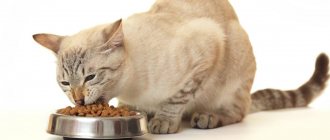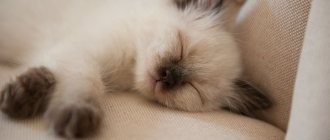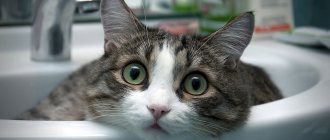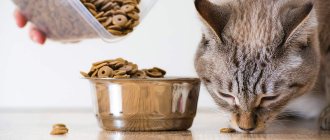Domestic cats are one of the most common companion animals. By type of nutrition, the cat is a strict (obligate) predator. This means that the cat prefers to eat prey that it has killed itself. We offer you general recommendations for feeding cats. A cat's needs will depend on its breed, size, age, energy level and health problems. Consult your veterinarian about how many calories your cat should consume each day and how to structure her diet.
- Cat nutrition features
- How a cat feeds kittens
- What to feed a cat: what natural products can be given to a cat
- Is it possible to give a cat fish, pork, milk, raw liver, bones, smoked meats?
- What other foods should you not give to your cat?
- How and how much to feed a cat
- How to give your cat dry food
- What is not recommended to do when feeding cats dry food
Cat nutrition features
Cats do not eat carrion and very rarely eat a little grass to clear the gastrointestinal tract of hair and bone fragments. The main part of the diet of small representatives of the cat family is mouse-like rodents. Cats also often eat small birds, insects and frogs. They eat prey starting from the head, then eat the contents of the intestines. Wild felines obtain all plant products from the stomach contents of their victims. Birds are pre-plucked by cats.
As is known, the greater the ratio of the length of the intestine to the length of the animal’s body, the more adapted it is to digesting and assimilating plant foods. In the domestic cat, the intestine is approximately four times longer than the body length. For comparison, in herbivorous mammals this ratio is 15-20 times. Therefore, a cat cannot become a vegetarian.
Domestic cats and seals have the following interesting nutritional features:
- cats cannot synthesize retinol (vitamin A) from carotenoids contained in fruits and vegetables;
- The cat's diet should contain from 30 to 40% protein (protein);
- There is a substance in a cat's coat that contains B vitamins. When a purr licks itself, it calms down thanks to this;
- cats do not tolerate prolonged fasting very well;
- cats cannot taste sweetness.
At what age is the best time to start transitioning kittens to solid food?
It is necessary to start introducing complementary foods no earlier than the kittens open their eyes, gain strength and, with the help of mother's milk, train their immunity. 3-4 weeks of age is the optimal time to start transitioning babies to solid foods. Usually by this point they themselves begin to show interest in the contents of the mother cat's bowl.
It is necessary to start feeding small pets on time, because when they reach a month, the components of milk are no longer enough for the full development of a rapidly growing organism and the enzyme responsible for the absorption of lactose is produced less and less.
What to feed a cat: what natural products can be given to a cat
If you prefer to feed your cat natural products, there are several rules to consider.
What natural products can be given to a cat:
- To balance the diet, it is necessary to provide a high-quality vitamin and mineral complex.
- Preferred types of porridge in small quantities: rice and buckwheat. Or rice and buckwheat flakes.
- Of the by-products, the heart is the most preferable.
- Beef can be given raw or scalded with boiling water; it is better to boil other raw meat products.
- Raw chicken egg white contains avidin, which destroys B vitamins. Therefore, it is better to give the egg boiled or give the cat only the egg yolk.
Is it possible to give a cat fish, pork, milk, raw liver, bones, smoked meats?
Cats should not be given raw fish . River fish may contain pathogens of dangerous helminthic diseases. Raw sea fish contains the enzyme thiaminase, which destroys the vitamin thiamine, the lack of which can lead to nervous system disorders. In addition, fish contains excess phosphorus, which often leads to urolithiasis.
Boiled fish , especially mixed with rolled oatmeal, can also lead to urolithiasis. This mixture contains excess phosphorus due to fish, and rolled oats alkalizes the urine. Sharp small fish bones are very dangerous for cats. A little boiled fish won't hurt, but it shouldn't be your main meal.
Pork should not be given to cats due to its high fat content. In addition, pork and rabbit meat, especially in entrails that have not passed veterinary control, may contain pathogens of dangerous diseases.
Raw liver can cause stomach upset and even an excess of vitamin A. Pork liver is especially dangerous. Adult cats often experience stomach upset from whole cow's milk due to a deficiency of the enzyme lactase, which is involved in the digestion of the milk sugar lactose. It is better to accustom your cat to low-fat fermented milk products. If your pet cannot live without milk, then the milk must be diluted with boiled water and added egg yolk. Sometimes you can treat your pet with cheese or low-fat cottage cheese.
Bones should not be given to pets. They can cause gastrointestinal injuries.
What other foods should you not give to your cat?
- Chocolate, onions and garlic, and avocados are poisonous to cats.
- Do not give hot, spicy, salty, smoked or fried foods.
- Sour foods should not be given to pets.
- An excess of B vitamins and biotin darkens the color of cats with color point markings. These include cats of Siamese and Himalayan colors.
Fermented milk products
If the owner prefers to feed the ward natural food, he includes fermented milk products (kefir, cottage cheese, yogurt) in the menu. However, there are a number of nuances here too.
“Sour milk” contains useful microelements and substances. They destroy harmful bacteria in the pet's body. In addition, these products have a beneficial effect on the immune system and protect against many diseases.
The choice of fermented milk products should be treated with due care. The main factor is the percentage of fat
For cottage cheese it should not exceed 9%. Other products (ryazhenka, yogurt, kefir) are allowed. However, their fat content should be no more than 3.5%. Sour cream with 10% can be diluted with water and given to your pet. All yoghurts and other sweet foods are completely excluded. Because they only harm the cat’s body.
How and how much to feed a cat
With a natural diet, kittens are fed 5-6 times a day. The requirements for products are the same as for adult animals. Small kittens digest milk, but it is better to give them either special ready-made milk formulas (sold in pet stores) or whole goat milk.
Adult cats are fed 2-3 times a day. Do not try to please the animal by treating it with delicacies. This will cause the cat to become capricious.
If you have multiple cats in your home, keep in mind that the amount of food offered should not exceed the total daily calorie requirements for all cats. Otherwise, your cat or cats may become overweight, increasing the risk of developing health problems.
Is it possible to give milk to a fold-eared kitten, will it harm it?
A popular horror story that can sometimes be heard even from breeders: if you feed lop-eared kittens with cow's milk, their ears can “stand up.” This warning is justified by the fact that kittens with drooping ears should not receive too much calcium. None of this is true; tailed babies of any breed need all the beneficial nutrients. As for the shape of the ears, sometimes they actually rise as the kitten grows. However, this depends little on nutrition. We are talking about the defect of the breed and the individual physiological characteristics of a particular animal. Accordingly, the answer to the question whether a Scottish kitten can be given milk or not is positive. This product can be present in the diet of tailed babies up to 4 months of age.
How to give your cat dry food
Feeding dry food is convenient, especially if the owner works. Free access to dry food is preferable, then the cat can eat small portions up to 40 times a day. Canned food from the same manufacturer can be an addition to dry food. When feeding high-quality dry food, there is no need to provide additional vitamins and minerals, since the finished food is completely balanced. Ready-made food includes additives for the prevention of urolithiasis. The manufacturer's recommendations must be strictly followed. On the packaging of good food there is a table with the dosage of food depending on the age, body weight of the animal and its physiological condition.
Caring for newborn and older kittens
To create comfortable conditions for furry babies, you need to take care of their place of residence. A large basin or cardboard box will serve as a “dwelling”, but you will have to constantly ensure that it does not get wet. For this purpose, absorbent material is purchased that absorbs excess moisture.
In the first days of life, kittens especially need warmth, so it is advisable to install a heater near their place of residence. If you don't have one, use a heating pad wrapped in a towel or a hot water bottle. Don’t forget: the minimum ambient temperature in the first two weeks of a baby’s life is kept at 30° C. After 14 days, lower the temperature to 24° and do not change it for another three weeks.
At three weeks of age, babies begin to try to walk: be careful that they do not fall out of their nest and get injured. The first walks should take place under your watchful supervision.
Try not to let kittens onto the carpet: they do not yet know how to retract their claws and therefore constantly cling. In worst cases, the baby may be injured.
At the fifth week of life, kittens see well and move actively. Then they are introduced to the first complementary foods. By 6 weeks of age they can eat solid food, and at 8-10 weeks they can be given to new owners.
To monitor the development of kittens, you will need an accurate scale. Weighing babies is necessary for:
- calculating the volume of daily portions;
- tracking growth rates.
If your kitten is not gaining weight well, you should consult your veterinarian. Perhaps the baby is malnourished or sick with something.
What is not recommended to do when feeding cats dry food
- Mix dry and canned food from different brands. This way you upset the balance of your diet in terms of nutrition, vitamins and minerals.
- Mix natural foods and dry food.
- Do not monitor your drinking regime. For one part dry food, your cat needs to drink four parts water. Milk and broth are food! If the cat drinks little, then it needs to be given canned food from the same manufacturer (it contains only 10% dry matter). Often, owners provide cats with double bowls for food and water. It is not right. Food and drinking water should be in separate places. This way the water will remain clean longer and the food will not get wet. You can put water for your cat in a glass jar. This way you will see how much water your cat drinks per day. Fountain drinking bowls are popular (look for them in a pet store).
- Transferring from one type of food to another or changing dry food is carried out within 5-7 days. Gradually mix the new type of food with the usual one.
- With proper nutrition, the cat has normal fatness (no excess fat), the cat is cheerful and cheerful, it has shiny, tangle-free fur and good daily stool. You should be wary of weight gain or thinness, permanent shedding, constipation or indigestion.
- Urolithiasis most often affects castrated and sterilized cats. Feed them high-quality dry food or raw meat with the addition of cereals in the form of porridge, egg yolk and fermented milk products. Do not feed boiled fish with rolled oats! Monitor the drinking regime and do not overfeed the animal. At risk are neutered cats, animals of the Persian breed and related ones, as well as outbred cats and female cats. Red cats are most seriously ill.
Fermented milk products
If the body reacts poorly to milk, then you can give sour dairy products to your cat. Preference is given to kefir and cottage cheese. They contain a lot of calcium, which helps maintain healthy hair, bones, teeth, and claws.
Fermented milk products are produced in two ways
:
- Lactic acid fermentation (yogurt, cottage cheese, sour cream). Such products must be given to the cat fresh so that the expiration date is met.
- Mixed fermentation, where fermented milk product and alcohol (kumys, kefir) are used. In this case, before feeding, you need to find out when the product was manufactured. The older it is, the higher its alcohol concentration.
The owner should know that kefir, which is no more than 2 days old, has a laxative effect. If the product is more than 2 days old, then, on the contrary, it strengthens. In this regard, if the animal is prone to constipation, it is necessary to feed it exclusively with fresh kefir, and if it has diarrhea, with old kefir.
However, not every cat will agree to eat ripened kefir, since it is very sour. In this case, you can replace it with biokefir, which contains probiotics. Thanks to these components, the intestinal microflora and stool are restored.











